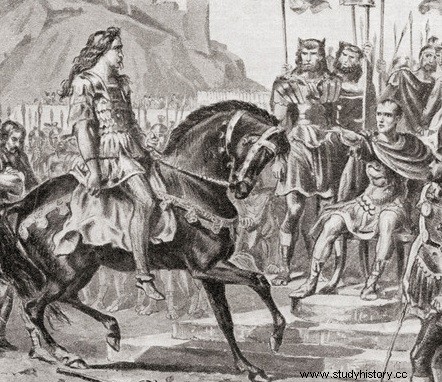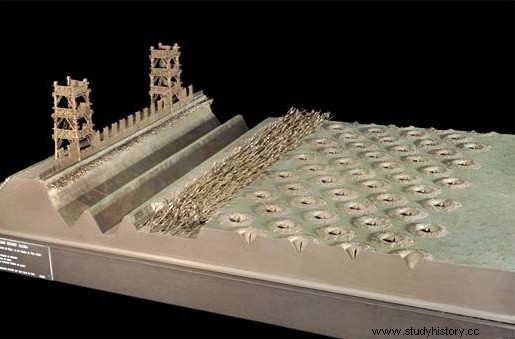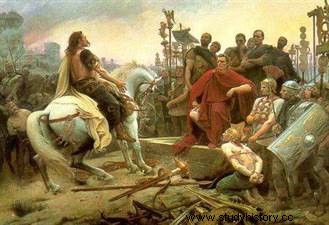 Epilogue to the Gallic Wars, the Battle of Alesia ends in August 52 BC with the victory of the Roman legions of Julius Caesar over a Gallic coalition commanded by Vercingetorix. Despite his previous success at Gergovie, the young Gallic leader was forced to take refuge in Alesia by a skillful Roman counter-attack. In a few days, the oppidum was surrounded by considerable earthworks. The offensives of the relief armies, like those of the besieged, came up against the powerful defense system put in place by the Romans. Vercingetorix must surrender, and his army capitulate. The fall of Alesia will lead to the submission of the main Celtic peoples, and Roman Gaul will become one of the most prosperous provinces of the Empire.
Epilogue to the Gallic Wars, the Battle of Alesia ends in August 52 BC with the victory of the Roman legions of Julius Caesar over a Gallic coalition commanded by Vercingetorix. Despite his previous success at Gergovie, the young Gallic leader was forced to take refuge in Alesia by a skillful Roman counter-attack. In a few days, the oppidum was surrounded by considerable earthworks. The offensives of the relief armies, like those of the besieged, came up against the powerful defense system put in place by the Romans. Vercingetorix must surrender, and his army capitulate. The fall of Alesia will lead to the submission of the main Celtic peoples, and Roman Gaul will become one of the most prosperous provinces of the Empire.
The context:the Gallic Wars
Inseparable from each other, the sieges of Gergovie and Alesia were the two major events of the Gallic Wars. In 52 BC. J.-C., while all of Gaul seems to have fallen under Roman domination, Vercingetorix, an Arverne chief, fails to overthrow everything by managing to raise and unite a large part of the Gallic peoples. Practicing a strategy of scorched earth and harassment of supply lines, Vercingetorix almost manages to starve the Roman troops before they seize Avaricum (Bourges), deemed impregnable and therefore left intact.
 The population was massacred and Caesar, having reconstituted his stocks of food, pursued them with six legions and Gallic allies allied to Gergovia (perhaps near Clermont-Ferrand). The siege is a disastrous failure, Caesar admitting in particular the loss of forty-six centurions in the assault on the oppidum. With the Aedui cavalry defecting and threatening to cut him off from Provincia, Caesar had little option but to rush north to rally the four legions left behind by his legate Labienus.
The population was massacred and Caesar, having reconstituted his stocks of food, pursued them with six legions and Gallic allies allied to Gergovia (perhaps near Clermont-Ferrand). The siege is a disastrous failure, Caesar admitting in particular the loss of forty-six centurions in the assault on the oppidum. With the Aedui cavalry defecting and threatening to cut him off from Provincia, Caesar had little option but to rush north to rally the four legions left behind by his legate Labienus.
It was then that, given confidence by his resounding success, the flight of his formidable adversary and the gradual rallying of the majority of the Gallic peoples, Vercingetorix decided to try to block his road and surround it by surprise, taking advantage of its powerful cavalry. The fierce resistance of the Romans and the German auxiliaries thwarted the attempt and forced the routed Gallic army to withdraw en masse to the great oppidum of Alesia, in Burgundy. The Roman genius then gave full measure of its organization and its techniques of poliorcetics (the art of sieges) by surrounding the defenders with a double fortified line topped with towers and flanked by ditches and obstacles.
The art of the siege in Alesia
Alésia is a fortified site of nearly one hundred hectares. Its defensive system is based on the use of a steep cliff and thick ramparts built using the murus gallicus technique on the east-west sides. During the siege of the city in 52 BC. AD, the Romans had to face not only the defenders of the oppidum, but also the Gallic army that had come to their aid. In five weeks, the legionnaires build a hitherto unprecedented system of fortifications. They build a double protection of fortified lines, built with stones and turf.
 The first, the contravallation, is 15 km long and oriented towards the oppidum in order to resist the exits of the 80,000 Gauls entrenched. The second, the circumvallation, is a 20 km line facing outward to thwart the army that came to help Vercingetorix. actually unearthed the weapons and traps used (goads, wolf traps, etc.) as well as Celtic and Roman coins. We now know that the defense systems were multiple.
The first, the contravallation, is 15 km long and oriented towards the oppidum in order to resist the exits of the 80,000 Gauls entrenched. The second, the circumvallation, is a 20 km line facing outward to thwart the army that came to help Vercingetorix. actually unearthed the weapons and traps used (goads, wolf traps, etc.) as well as Celtic and Roman coins. We now know that the defense systems were multiple.
The ingenious Roman defences
In each fortified line, obstacles are established in order to stop the advance towards the Roman army. Two ditches 4.50 m wide and 2.50 m deep were dug. 90 cm holes are staggered with, at the bottom of each of them, a pointed stake. The holes are then hidden with brush. Finally, there are five lines of 1.50 m deep ditches in which are fixed large branches tied to each other. The lines are surmounted by a 4 m high rampart, punctuated by 24 m high wooden towers.
The Roman army consisted of ten to twelve legions, which gives almost 70,000 legionnaires. Before the arrival of relief troops, Vercingetorix had 80,000 men and could hold out for a month. The Gallic army, made up of 250,000 men and 8,000 cavalry, arrived two months later, as famine and lack of water began to wreak havoc on the city. To limit unnecessary human losses, Vercingetorix gives the order to expel the civilians. When the Gallic relief cavalry tried to invest the Roman defences, they found themselves defeated and pursued by Caesar's German cavalry which had come out en masse.
The Battle of Alesia
The encounter sealing the fate of the campaign, and radically upsetting the future of Gaul, takes place on a full moon night, in August or September -52, when a force An elite group of sixty thousand (?) Gallic warriors attacked the upper Roman camp from the outside while Vercingetorix attempted a general sortie. “Vercingetorix, seeing his people from the top of the citadel of Alesia, left the square; he had fascines, poles, protective roofs, scythes, and everything he had prepared for an outing carried forward.
We fight everywhere at once, we attack all the works; a point seems weak, we go there en masse. (Caesar). The Gauls fail to prevail over two Roman legions which come to reinforce Labienus, at the head of another legion, and numerous detachments brought in from the fortified line. Caesar, managing for his part to repel the attackers, went en masse to the aid of his legates and brought out his cavalry to take the troops of Vercassivellaunos who was captured from the rear.
 The fleeing relief army and the besieged short of supplies and unable to break through the Roman lines, Vercingetorix is reduced the next day to offer his surrender. He adorns himself with his finest weapons, goes to find Julius Caesar and offers him his horse and his equipment. Several Roman texts written by Plutarch, Florus and Dion Cassius relate this surrender. According to the latter, Vercingetorix "could have escaped, for he had not been captured and remained without injury, but hoping (for he had once been in friendship with Caesar) to be able to obtain his pardon, he went to find him without to be announced”.
The fleeing relief army and the besieged short of supplies and unable to break through the Roman lines, Vercingetorix is reduced the next day to offer his surrender. He adorns himself with his finest weapons, goes to find Julius Caesar and offers him his horse and his equipment. Several Roman texts written by Plutarch, Florus and Dion Cassius relate this surrender. According to the latter, Vercingetorix "could have escaped, for he had not been captured and remained without injury, but hoping (for he had once been in friendship with Caesar) to be able to obtain his pardon, he went to find him without to be announced”.
If some, like Montaigne, believe that Vercingetorix is a bad strategist, others judge him equal to Caesar and consider that he has no had luck in Alesia. To explain this defeat, they evoke the great ruse of Caesar or even, sometimes, the fact that Vercingetorix maintained a complicity with the Roman general. Finally, they insist on the interest of the strategy he developed throughout the year 52 BC. AD, before and during the siege. We observe that during this year, the Gauls set fire to farms and villages to cut off the supply of the Romans, isolate them, concentrate them in the same place and exhaust them by means of a long and painful siege. The attack on Alesia also seems to have been planned.
The consequences of Caesar's victory at Alesia
The great architect of the Gallic revolt will appear in Caesar's triumph in Rome and will end up strangled in his cell. Most defeated warriors are enslaved and given to Roman legionnaires, one per head. Alésia, "the greatest disaster in our history" as historian Ferdinand Lot would say in a slightly dated "Gallic" perspective... Disaster or not, a matter of point of view.
But in addition to its crushing symbolic weight, Alésia certainly represents by its scale and its consequences one of the greatest battles in the history of "French territory", even by bringing back the effective combatants to more reasonable figures than those of ancient sources and the Caesar calculator. The fact remains that after a final revolt led by the Atrébate Commios in -51, the Gauls will definitely be under Roman domination, and this for nearly five centuries, giving birth to the Gallo-Roman civilization.
After many hypotheses, Alésia is now located on the dominant site of Alise-Sainte-Reine, in the Côte d'Or.
Bibliography
- Alesia:52 BC, by Yann Le Bohec. Text, 2019.
- The Gallic Wars, by Julius Caesar. GF, 1993.
